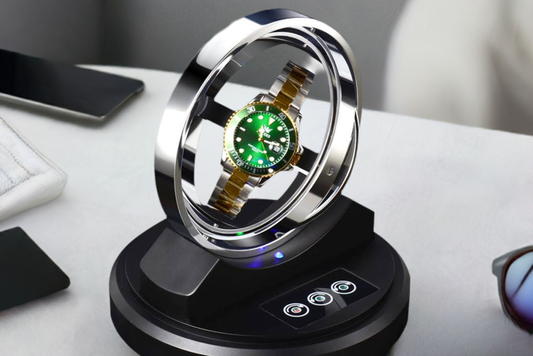Understanding Rolex Winding Mechanics
Automatic vs. Manual Winding Rolex Models
Rolex offers both automatic and manual winding models. Automatic models, such as the Datejust, Submariner, and Oyster Perpetual, feature the Perpetual rotor, a self-winding mechanism that harnesses energy from the wearer's wrist movements to power the watch. Manual winding models require regular winding by the wearer to maintain power.
How the Perpetual Movement Works in Self-Winding Rolexes
Invented by Rolex in 1931, the Perpetual movement is a self-winding caliber that uses a centrally-mounted winding weight to rotate 360 degrees, generating energy from the wearer's movements. This energy is stored in the mainspring, which powers the watch, eliminating the need for manual winding.
Precision and Performance
Rolex's commitment to precision and performance is evident in its use of advanced materials and technologies. The paramagnetic blue Parachrom hairspring, introduced in 2000, improved reliability and precision by tenfold. The Paraflex system, patented in 2005, enhances shock resistance by up to 50%. Rolex's in-house lubricants and high-performance materials, such as the niobium-zirconium alloy, contribute to the exceptional performance of its movements.
Credit: YouTube Channel - Bob's Watches - Buy \u0026 Sell Rolex
Winding a Rolex Watch
While Rolex's self-winding mechanism eliminates the need for daily winding, manual winding may be necessary if the watch hasn't been worn for an extended period (typically 48 hours). Follow these steps to wind your Rolex:
- Unscrew the crown by turning it counterclockwise until it pops out from the case.
- Turn the crown clockwise slowly and in full rotations using your thumb and index finger.
- Repeat the process for about 30-40 times for a full wind.
- Pull the crown out gently by one click and turn it clockwise to change the date.
- Pull the crown out fully to reset the hands.
Rolex's Commitment to Excellence
Rolex's dedication to excellence is reflected in its rigorous testing and certification processes. The COSC (Swiss Official Chronometer Testing Institute) certifies Rolex movements as chronometers, ensuring they meet stringent requirements for precision, shock-resistance, reliability, and self-winding capability. Rolex's in-house testing further guarantees exceptional performance.
Winding Techniques for Specific Models
Rolex Datejust
To wind a Rolex Datejust, follow these steps:
- Unscrew the crown by gently pulling it out to the first position and turning it counterclockwise until fully unscrewed.
- Wind the watch by turning the crown clockwise 30-40 times for optimal performance.
- Screw the crown back in a clockwise direction until fully tightened to ensure waterproofness.
Rolex Submariner
When winding a Rolex Submariner, consider the following:
- Before diving, set the time and date correctly by rotating the crown clockwise for the date and counterclockwise for the time. Avoid the date-changing mode between 11 PM and 1 AM to prevent damage.
- Wind the Submariner by rotating the crown clockwise until you feel resistance. Do not overwind, as this can damage the mechanism.
- For divers, ensure the watch is fully wound before entering the water, as water pressure can affect accuracy at great depths. Regularly inspect the O-ring gaskets for a tight seal.
Oyster Perpetual
The Oyster Perpetual's unique self-winding mechanism, or rotor, harnesses the wearer's movements to wind the watch. To maintain accuracy:
- Wear the watch regularly to keep it wound.
- Avoid extreme temperatures above 60°C (140°F) or below -20°C (-4°F).
- Keep the watch away from strong magnetic fields.
- Service the watch regularly by a certified Rolex watchmaker for cleaning, lubrication, and part replacement.
- Store the watch in a cool, dry place away from direct sunlight when not in use.
Common Misconceptions Debunked
Turning Counterclockwise: Does it Damage the Watch?
While turning the crown counterclockwise excessively or with too much force can potentially damage the watch's gears and mechanisms, Rolex watches are designed to withstand normal use, including gentle clockwise and counterclockwise winding within recommended torque specifications.
Setting the Time: Avoiding Common Mistakes
To avoid mistakes when setting the time, ensure the crown is pulled out to the correct position:
- First position: Winding
- Second position: Setting the date
- Third position: Setting the time
Refer to the watch's manual or consult a professional if unsure about the correct procedure for your specific Rolex model.
Rolex Maintenance and Servicing
How Often to Service Your Rolex
Rolex recommends servicing their watches every 5 to 10 years, depending on the model, usage, and environmental conditions. If you notice any signs of winding mechanism issues, have your watch serviced promptly.
Signs Your Rolex Needs Winding Mechanism Service
- Inconsistent timekeeping (running fast or slow)
- Reduced power reserve
- Difficulty winding
- Visible signs of wear on the winding stem, crown, or case back
Servicing Options
- Authorized Rolex Dealers: Visit for professional assessment and service using genuine Rolex parts.
- Independent Watchmakers: Ensure they have the necessary expertise and use genuine Rolex parts to maintain authenticity and warranty.
Adjusting for Sedentary Days and Active Wear
Understanding Rolex's Self-Winding Mechanism
Rolex's Perpetual rotor system automatically winds the watch using the wearer's natural arm motion. Manual winding is not necessary if the watch receives adequate motion.
Adjusting for Sedentary Days
For sedentary lifestyles or infrequent wear, manual winding or a watch winder may be necessary to maintain the power reserve. Some owners prefer manual winding when switching between watches.
Impact of Wearing Habits on Automatic Winding
The frequency and duration of wear significantly impact automatic winding. Daily wear with sufficient motion usually eliminates the need for manual winding, while extended periods of inactivity may require manual winding or a watch winder to maintain power.
Maintaining Your Rolex
Proper maintenance, including washing, cleaning, and manual winding after extended inactivity, is essential for longevity and accuracy. Regular servicing is also recommended for optimal performance.
Conclusion
Winding a Rolex is a crucial aspect of maintaining the accuracy and longevity of your luxury timepiece. By understanding the specific winding requirements for your Datejust, Submariner, or Oyster Perpetual, and following proper techniques, you can ensure your Rolex continues to perform at its best for years to come. Remember to have your watch serviced regularly and address any winding issues promptly to preserve its value and legacy.
We hope this comprehensive guide has provided valuable insights into the world of Rolex winding. If you have any questions or experiences to share, please leave a comment below. Don't forget to share this article with fellow Rolex enthusiasts who may find it helpful!
FAQ
How often should I wind my Rolex?
If your Rolex is worn regularly and receives sufficient motion, manual winding may not be necessary. However, if the watch has been inactive for an extended period (typically 48 hours or more), manual winding or the use of a watch winder is recommended to maintain the power reserve. It's also a good practice to wind your Rolex once a month, even if it's been worn regularly, to keep the gears lubricated and prevent them from drying out.
Can I overwind my Rolex?
While it is possible to overwind a Rolex, the watch is designed with a built-in protection mechanism to prevent damage from overwinding. When you feel resistance while winding the crown, it indicates that the mainspring is fully wound, and you should stop winding to avoid putting unnecessary strain on the mechanism. As long as you follow the recommended winding techniques and do not apply excessive force, you should not have to worry about overwinding your Rolex.
What should I do if my Rolex stops working after winding?
If your Rolex does not start running after manual winding, it may indicate an issue with the watch's internal mechanism, such as a broken mainspring or a defective gear. In such cases, it is best to bring your watch to an authorized Rolex service center or a qualified watchmaker for professional assessment and repair. Attempting to fix the issue yourself may cause further damage and void the watch's warranty.
Can I wind my Rolex while it's on my wrist?
Yes, you can wind your Rolex while wearing it on your wrist. To do so, unscrew the crown and turn it clockwise until you feel resistance. Be gentle and avoid applying too much pressure, as excessive force can damage the winding mechanism. Once you feel resistance, stop winding and screw the crown back in place. It's essential to ensure the crown is fully screwed down to maintain the watch's water resistance.




